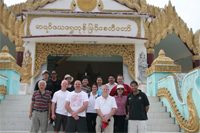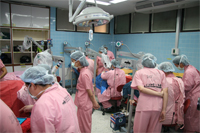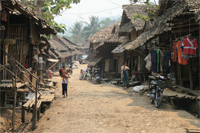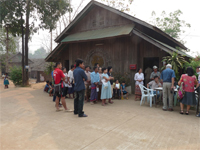 Every year since 1990, Dr. John Rutka, Otolaryngologist, UHN, along with his fellows have provided ear care in southeast Asia. This year, in conjunction with the Thai Rural Ear Nose and Throat Foundation (TRENTF), they visited refugee camps in Mae Sot, Thailand, near the Burmese border. The camp they visited houses approximately 60,000 Karen refugees seeking asylum from the civil unrest in Burma. When the camps were created, they were only meant to be a temporary holding area. Twenty years later, they continue to be a permanent feature of the landscape.
Every year since 1990, Dr. John Rutka, Otolaryngologist, UHN, along with his fellows have provided ear care in southeast Asia. This year, in conjunction with the Thai Rural Ear Nose and Throat Foundation (TRENTF), they visited refugee camps in Mae Sot, Thailand, near the Burmese border. The camp they visited houses approximately 60,000 Karen refugees seeking asylum from the civil unrest in Burma. When the camps were created, they were only meant to be a temporary holding area. Twenty years later, they continue to be a permanent feature of the landscape.
 The striking feature of the camp is the bamboo and banana leaf construction of the buildings. Citizens with very little raw materials and no wealth using all available natural resources built these huts to provide shelter and food. Despite the lack of amenities, the camp was clean with no litter or waste and each property meticulously ordered. Word soon spread of the visiting team and a long line of patients with ear disease developed rapidly. With little provision for follow up or medical treatment the team focused on identifying patients that would benefit from surgical management.
The striking feature of the camp is the bamboo and banana leaf construction of the buildings. Citizens with very little raw materials and no wealth using all available natural resources built these huts to provide shelter and food. Despite the lack of amenities, the camp was clean with no litter or waste and each property meticulously ordered. Word soon spread of the visiting team and a long line of patients with ear disease developed rapidly. With little provision for follow up or medical treatment the team focused on identifying patients that would benefit from surgical management.
 In this environment, chronic ear disease can be severely debilitating or even fatal, so surgery is a welcome relief. All cases were undertaken under local anaesthesia. Specially designed equipment was provided by TRENTF which combined efficiency with portability that has been recognized by awards from the World Health Organization (WHO) for the delivery of cost effective care.
In this environment, chronic ear disease can be severely debilitating or even fatal, so surgery is a welcome relief. All cases were undertaken under local anaesthesia. Specially designed equipment was provided by TRENTF which combined efficiency with portability that has been recognized by awards from the World Health Organization (WHO) for the delivery of cost effective care.
Members of the UHN team included Dr. John Rutka and his fellows, Dr. David Pothier, Dr. Prodip Das and Dr. Saisuree Nivatwongs with Ms. Natasha Peters (OR Nurse).
 Dr. Rutka and colleagues are looking at future ideas for ear surgical camps that move along the Mekong River and provide ear care to the six countries through which the river flows.
Dr. Rutka and colleagues are looking at future ideas for ear surgical camps that move along the Mekong River and provide ear care to the six countries through which the river flows.
